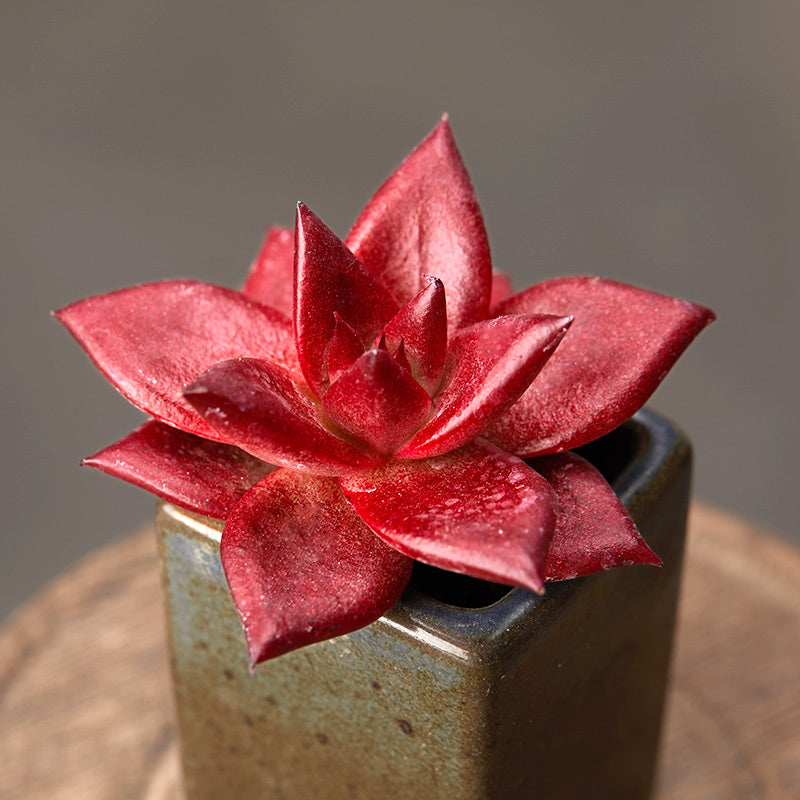Echeveria agavoides Romeo Rubin, a medium-sized variety, has a rosette-like plant structure with oblong, slightly thick leaves that taper sharply at the front. The leaves are smooth and often turn red, with a slight greenish hue near the center of the plant.
Echeveria agavoides Romeo Rubin belongs to the spring and autumn type of succulents. It thrives in environments with ample sunlight and good ventilation but cannot tolerate high temperatures. During winter, it should not be exposed to temperatures below freezing for extended periods. In hot summer weather, it needs to be placed in a cool and well-ventilated area for summer dormancy. In winter, the soil in the pot should be kept dry to avoid frost damage. Its natural flowering period mainly occurs in late spring and early summer, with flowers arranged in a scorpion-tail-shaped umbel inflorescence, either terminal or axillary. Compared to Romeo, Echeveria agavoides Romeo Rubin tends to turn red more easily, and when fully matured, the entire plant can turn blood-red. Maintenance can be similar to that of Romeo, but during summer, avoid prolonged periods of stuffiness or risk infection through wounds, which could lead to rot.
Echeveria agavoides Romeo Rubin's leaves are thick and elongated, with pronounced tips, appearing very smooth, almost wax-like, and extremely beautiful. Insufficient sunlight may result in tender green leaves, but most of the time, Echeveria agavoides Romeo Rubin appears red, giving it a passionate and flamboyant look, which adds to its high ornamental value and recognizability.
Echeveria agavoides Romeo Rubin is highly drought-resistant and has low water requirements. If you want young seedlings to grow more vigorously, you can use some peat soil. The recommended ratio of peat soil to granular soil is 5:5. For larger plants, this is mainly to control their shape, with at least 70% granular soil making it easier for them to reach a mature state.
While using more granular soil is beneficial for Echeveria agavoides Romeo Rubin's growth, there are many types and sizes of granular soil available. Avoid using overly large granular soil for planting Echeveria agavoides Romeo Rubin, as it has poor water retention and absorption capabilities, leading to dry and withered fine roots and shriveled leaves. It's best to use the smallest granular soil possible for planting Echeveria agavoides Romeo Rubin.
Echeveria agavoides Romeo Rubin's plants are not very large, so it's not recommended to use overly large flower pots. Large pots can prevent water from evaporating easily after watering, leading to prolonged soil moisture, which may cause Echeveria agavoides Romeo Rubin to grow excessively tall and suffer from root rot and waterlogging. The pot only needs to be one size larger than the plant, and you can consider repotting when the plant grows larger.
Echeveria agavoides Romeo Rubin loves light but should never be exposed to direct sunlight, especially during hot summers. When temperatures exceed 30 degrees Celsius, appropriate shading is necessary. As long as it's not exposed to intense sunlight, its leaves won't be sunburned, and its root system won't be affected, allowing Echeveria agavoides Romeo Rubin to grow normally.
Echeveria agavoides Romeo Rubin has low water requirements, and excessive watering can lead to root rot or blackening. Generally, wait until the potting soil has completely dried out before watering. If unsure, wait until the bottom leaves wilt before watering again. At this point, the plant is lacking water, and proper absorption will result in thicker leaves. It's advisable to directly expose Echeveria agavoides Romeo Rubin to sunlight during the spring and autumn seasons, with good ventilation and ample sunlight, which also helps Echeveria agavoides Romeo Rubin develop its color.
